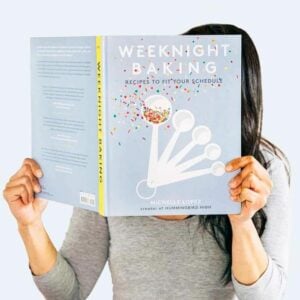Best Small Batch Baking Tools
Why You Need Small Batch Baking Tools
First things fist—let’s talk about why we need small batch baking tools in the first place. The truth is, you can get away with using regular sized equipment for 100% of my small batch baking recipes. In fact, full disclosure: I use my regular-sized KitchenAid Artisan Stand Mixer when developing the recipes. But using specialty small batch baking tools and equipment saves you time, effort, and energy.
In my cookbook, I wrote that I first started baking in college. I made boxed-mix brownies and cupcakes in a tiny, ill-equipped dorm kitchen without any fancy gadgetry. Instead of an electric whisk, I poured cream into a mason jar and shook it furiously to make whipped cream. And instead of a cookie dough scoop, I portioned cookie dough by rolling it into balls between my palms like Play-Doh. While these methods worked, they took twice as long as the recipe would have taken with the right equipment.
Similarly, most small batch baking recipes make smaller amounts of batters and doughs that don’t mix or knead as well in regular-sized equipment. The beater or dough hook has a harder time reaching small quantities of ingredients in a large mixer bowl. In fact, when developing my small batch baking recipes, I found myself scraping down the bowl of my mixer almost twice as often as I did with regular-sized recipes. It was the only way I could ensure that everything mixed properly When I finally scaled down to a smaller mixer, it worked wonders!
At the end of the day, your small batch baking will become faster, neater, and more efficient if you use the right equipment. So if you’re serious about becoming a small batch baker, I recommend investing in the tools below.
The Best Small Batch Baking Tools for Mixing and Processing
I recommend investing in a mini stand mixer, a handheld electric mixer, and a mini food processor for small batch baking recipes:
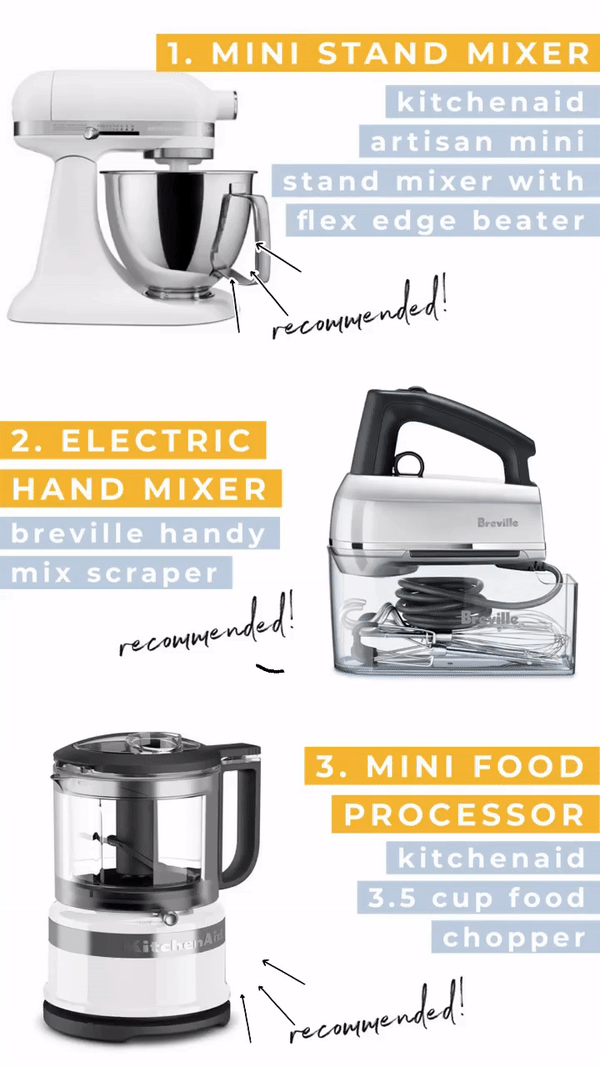
featured:
stand mixer || hand mixer || food processor
A Mini Stand Mixer
Recommended Mini Stand Mixer for Small Batch Baking: KitchenAid 3.5 Quart Artisan Mini Mixer
I’ve owned a KitchenAid mixer since 2011 and it honestly has revolutionized my baking. It is just so much more powerful, versatile, neater, and efficient than a hand mixer. I don’t think I could have become a cookbook author and the blogger you see today without one. I currently own several models, but the one I use most frequently is this KitchenAid Artisan Copper Metallic Series Stand Mixer (but only after a solid love affair with this Pistachio model).
Why A KitchenAid Mini Mixer is Better Than A Regular-Sized KitchenAid Mixer for Small Batch Baking
That being said, the most popular KitchenAid mixer models (you can read all about the different models here on their website) have a capacity of 5 quarts or more. In terms of volume, that’s around 20 cups. Most regular-sized cake recipes (think: a 3-layer, 8-inch cake or a 2-layer, 9-inch cake) average around 9 cups of batter. Small batch baking recipes (like this funfetti cake, this yellow cake, and this strawberry cake) clock in at around 2 cups. Now you can see why a smaller mixer matters, right? A smaller mixer will be able to mix batters and knead doughs more efficiently.
Luckily, KitchenAid also offers a mini version of their beloved Artisan mixer. It is 20% smaller and 25% lighter than their standard mixers. It was the mixer I used when I lived in New York City and had a tiny kitchen. The best part? Although it’s smaller size makes it perfect for small batch baking, it still has a capacity of 3.5 quarts (or 14 cups). That means you can still make regular-sized recipes in the mixer! Be sure to opt for a model with a flex-edge beater. The flex-edge beater scrapes down the side of the bowl as the paddle rotates, reducing the need for you to stop the mixer and do it yourself.
Other Mini Stand Mixer Recommendations
- {SAVE} KitchenAid Artisan Mini Stand Mixer with Flex Edge Beater (Available in multiple colors!)
- {SPLURGE} KitchenAid Artisan Mini Stand Mixer with Flex Edge Beater in Copper (This is the mini version of my regular-sized copper mixer—it’s pricier than the regular colors, but SO beautiful IRL.)
An Electric Hand Mixer
Recommended Hand Mixer for Small Batch Baking: Breville Handy Mix Scraper
If don’t want to spend the money on a mini stand mixer, an electric hand mixer is a great compromise. I recommend the Breville Handy Mix Scraper. It has a ton of useful features: a wide range of different speeds, spotlight that allows you to really see what you’re mixing, a built-in timer, and coated paddles to reduce noise. I love it so much that I was even interviewed about it by The New York Times’ review site, The Wirecutter.
Why Get A Hand Mixer Instead of A Stand Mixer
I know I literally just spent paragraphs gushing about my stand mixer. But here’s the truth: an electric hand mixer works just as well for small batch baking recipes as a mini stand mixer (though I wouldn’t say that were the case for regular-sized recipes, but let’s save that for another blog post). Why? You can use small bowls with hand mixers, providing the reach and access to the ingredients that a stand mixer with a big bowl can’t.
Other Hand Mixer Recommendations
- {SAVE} Hamilton Beach 6-Speed Electric Hand Mixer (This is the budget hand mixer I first bought for myself in my sophomore year of college. Although it doesn’t have many bells and whistles, it took a beating and lasted me until the early days of this blog.)
- {SPLURGE} Cuisinart Power Advantage Plus 9-Speed Handheld Mixer (Full Disclosure: I haven’t tried this Cuisinart product myself, but I own lots of other Cuisinart small appliances and love them! I recommended this one because it came second in The Wirecutter‘s reviews after the Breville Handy Mix Scraper, despite being significantly cheaper.)
A Mini Food Processor
Recommended Mini Food Processor for Small Batch Baking: KitchenAid 3.5 Cup Food Chopper
I bought a KitchenAid 3.5 Cup Food Chopper after seeing a professional chef use it in her kitchen to whip up one of the best salad dressings I’ve ever had in my life. Her demo was a wonder: she carelessly threw in a handful of herbs, onions, olive oil, and vinegar and processed them all together to create a creamy salad dressing.
And while I use this food processor a lot for my savory cooking, I use it a lot for my small batch baking, too. It’s perfect for chopping up ½ cup to 1 cup quantities of baking ingredients like chocolate, fruit, nuts, and more.
Why A Mini Food Processor is Better Than A Regular-Sized Food Processor for Small Batch Baking
Most regular-sized food processors can hold either 10 or 12 cups of ingredients inside their bowls. Unfortunately, most small batch baking recipes typically max out at 1 to 2 cups per ingredient. And honestly, even those larger quantities are rare—looking through my small batch baking recipes, I usually only call for ½ cup quantities of ingredients.
Similar to using a mini stand mixer, a smaller food processor will allow you to process small batches of ingredients more efficiently. When I’ve tried to process small quantities of ingredients in my big, bulky 12 cup-capacity food processor, I’m always surprised by two things: The first—how incredibly loud it is. Those smaller quantities of ingredients in big bowls really rattle! The second—how much longer I need to process the ingredients for (since small quantities of ingredients spend less time coming into contact with the blade due to all that rattling around. A smaller food processor will save you time (really). Not to mention energy, too. Smaller food processors are much easier to move around than their heavy, regular-sized counterparts.
Other Mini Food Processor Recommendations
- {SAVE} Cuisinart Mini Prep Plus Processor (I had this one for years before I lost it in a move between apartments—losing this food processor was finally what convinced me to switch to the KitchenAid model I mentioned above, lol. But the Cuisinart is also great and I would have bought it again had I not seen the KitchenAid demo!)
- {SPLURGE} KitchenAid Cordless 5 Cup Food Chopper (This food processor looks like an update to the model I recommended above. It has a slightly bigger capacity, and it’s CORDLESS! Swoon. I might just have to put it on my wedding registry.)
Best Cake Pans for Small Batch Baking
Small batch baking recipes yield smaller quantities than traditional baking recipes. To account for this, you need smaller baking pans. Here are the best cake pans for small batch baking:
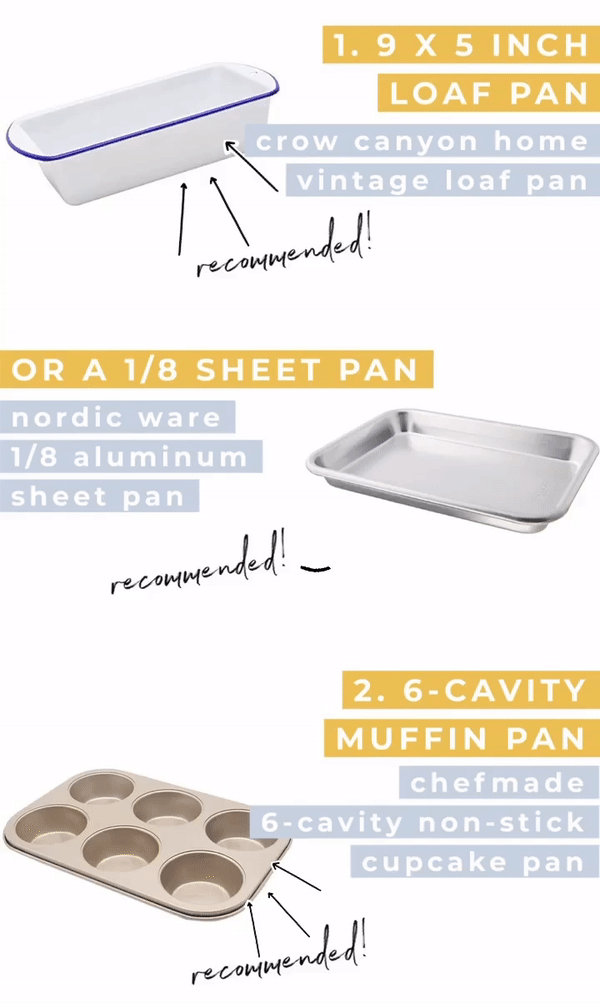
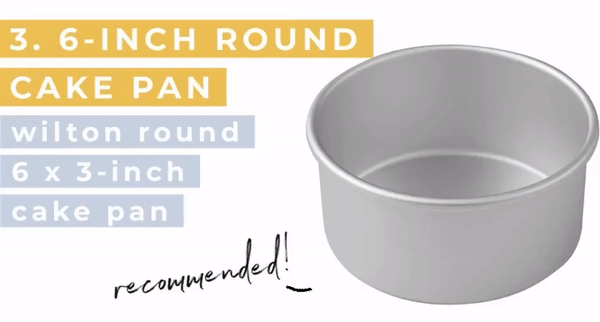
featured:
loaf pan || sheet pan || muffin pan || cake pan
A 9 x 5-inch Loaf Pan or A ⅛ Sheet Pan
Why You Need A 9 x 5-inch Loaf Pan (or A ⅛ Sheet Pan) For Small Batch Baking
To make very small batch sheet cakes like this yellow cake, this strawberry cake, this funfetti cake, and this American flag cake, duh! Most regular-sized batch sheet cake recipes instruct you to bake them in half sheet pans (which clock in at 18 x 13-inches), or quarter sheet pans (which clock in at 13 x 9-inches). While the former feeds a whopping 48 people (wild!), the latter still feeds a fairly sizable number of 20 folks.
However, the small batch sheet cake recipes I’ve been developing make a quarter of those portions. That’s enough to only make 2 generous servings, 4 regular-sized ones, and 8 petite portions. I bake these cakes in a 9 x 5-inch loaf pan. I’ve also made small sized tray bakes like brownies and magic cookie bars in loaf pans.
A 9 x 5-inch Loaf Pan versus A ⅛ Sheet Pan
Okay, let’s talk sheet pans for a second. Standard sheet pan sizes are as follows:
- Full Sheet Pan: 26 x 18-inches
No home baker I know actually has one of these at home. They’re massive and mostly used by professional bakeries and restaurants to make commercial-sized batches of baked goods. - Half Sheet Pan: 18 x 13-inches
In case you couldn’t tell by its name, a half sheet pan is literally half the size of a full sheet pan. These are still fairly big baking trays, but more accessible to the home baker. Typically, Texas sheet cakes and cinnamon roll recipes are baked in these pans. - Quarter Sheet Pan: 13 x 9.5-inches
Similar to the half sheet pan, the quarter sheet pan’s name indicates that it is a quarter of the size of a full sheet pan. This is the most common sheet pan used in most home baking recipes. Many cakes, brownies, and cookie bar recipes instruct you to bake them in a 9 x 13-inch rectangular baking pan or sheet pan. A quarter sheet pan is roughly half the size of a half sheet pan. - Eighth (or ⅛) Sheet Pan: 9.5 x 6.5-inches
Finally, we have the humble eighth sheet pan. Similar to the sizes preceding it, the eight sheet pan’s name indicates that it is an eighth of the size of a full sheet pan. An eight sheet pan is also roughly half the size of a quarter sheet pan, and a quarter of the size of a half sheet pan.
If you want to be SUPER legit about small batch baking, go ahead and purchase a ⅛ sheet pan! But it turns out the bottom surface area of a 9 x 5-inch loaf pan is pretty similar to that of an official ⅛ sheet pan. So I recommend using a 9 x 5-inch loaf pan in my recipes instead because the loaf pans are much more versatile. Why? A loaf pan has high sides (typically 3 to 4 inches tall) that you can use to bake loaf recipes in, whereas a ⅛ sheet pan has shallow sides (typically only 1 inch tall).
If you do end up buying an ⅛ sheet pan, you’ll probably need to adjust the Bake Times of my small batch baking recipes that are baked in a 9 x 5-inch loaf pan. I would check for doneness 5 to 10 minutes earlier than what’s listed in the recipe.
Recommended 9 x 5-inch Loaf Pan for Small Batch Baking: Crow Canyon Home Loaf Pan
I bought this loaf pan at West Elm several years ago because I thought it was just SO pretty. Apparently several of you agree with me—any time I post a recipe on Instagram that uses this pan, I get many DMs asking me where I got the pan! But here’s the best part: not only is the pan pretty, it also holds UP. I’ve been baking with this pan since 2013 and, despite my heavy use, its enamel coating still hasn’t scratched or chipped. Legit.
Note: I don’t think West Elm carries the pan any longer, but you can purchase it still from Amazon. I think they’ve discontinued the black and white color I use, but Crow Canyon still sells a pretty blue and white version that I have in my Amazon wishlist.
Other 9 x 5-inch Loaf Pan Recommendations
- {SAVE} USA Pan Bakeware Aluminized Steel Loaf Pan (This pan is very sturdily made, and its ridged texture promotes even baking.)
- {SPLURGE} Williams Sonoma Goldtouch® Nonstick Loaf Pan (If I want something sturdier than my enamelware loaf pan, I usually use this loaf pan. I LOVE everything in Williams Sonoma’s Goldtouch Nonstick line—it’s the exact brand I recommend in my cookbook!)
Recommended ⅛ Sheet Pan for Small Batch Baking: Nordic Ware ⅛ Sheet Pan
Since eighth sheet pans aren’t a common or popular pan for baking and cooking, you don’t really get too much variety to choose from. I own this Nordic Ware ⅛ Sheet Pan sheet pan. It’s a pretty standard, solid (if a little boring) sheet pan.
Small Batch Baking Recipes That Use A Loaf Pan or ⅛ Sheet Pan
- Brownies
- Funfetti Sheet Cake
- Magic Cookie Bars
- Mini American Flag Cake
- Strawberry Sheet Cake
- Yellow Cake with Chocolate Frosting
A 6-Cavity Muffin Pan
Recommended 6-Cavity Muffin Pan for Small Batch Baking: CHEFMADE Muffin Cake Pan
Most small batch muffin recipes make half a dozen (or less!) muffins. If you want to scale down and buy a specialized small batch muffin pan, I recommend this CHEFMADE muffin pan. Its champagne gold color is very pretty in real life—not to mention functional, too! Always avoid buying black or dark-colored baking pans. Dark colors tend to absorb more heat in the oven, causing your baked goods to cook more quickly around the edges while leaving a raw center.
Do you really need a new muffin pan for small batch baking?
Okay, real talk: you don’t REALLY need a specialized muffin or cupcake pan for small batch baking. In a pinch, your regular 12-cavity muffin pan will do the job just fine! However, don’t forget to fill any empty cavities with hot water. Doing so promotes even baking. Muffin pans are typically designed to baked at full capacity; if some of the cavities aren’t filled with batter, the filled ones have a tendency to bake too quickly and overcook.
Small Batch Baking Recipes That Use A 6-Cavity Muffin Pan
Two or Three 6-Inch Cake Pans
Recommended 6-inch Cake Pan for Small Batch Baking: Wilton 6 x 3-Inch Round Cake Pan
Most layer cake recipes are baked in 8- or 9-inch cake pans and feed a crowd. If you want to scale down those recipes, I recommend investing in smaller, 6-inch cake pans. Buy at least two (but preferably three) of the same cake pan to ensure even cake layers. I also recommend getting a cake pan with tall sides—at least 3-inches tall!—to prevent the batter from rising up and overflowing. These Wilton cake pans fit my recommendations.
Other 6-Inch Cake Pan Recommendations
- {SPLURGE} Williams Sonoma Goldtouch® Nonstick 6-inch Round Cake Pans (If you want something nonstick, I recommend these Williams Sonoma pans. Like I said before, I LOVE everything in this line and have most of the cake pans in this collection!)
Small(er) Baking Recipes That Use A 6-inch Cake Pan
- Banana and Chocolate Crunch Cake with Graham Cracker Frosting
- Classic Yellow Cake with Chocolate Creme Fraiche Frosting
- Chocolate Orange Cake with Salted Cream Cheese Frosting
- Triple Chocolate Banana Cake
- Valentine’s Red Velvet Cake
- Yellow Birthday Cake with Chocolate Frosting For Two
Best Small Batch Baking Tools for Measuring Ingredients
Some of the best and most essential small batch baking tools are the ones used for measuring ingredients. I recommend the following measuring tools for small batch baking recipes:
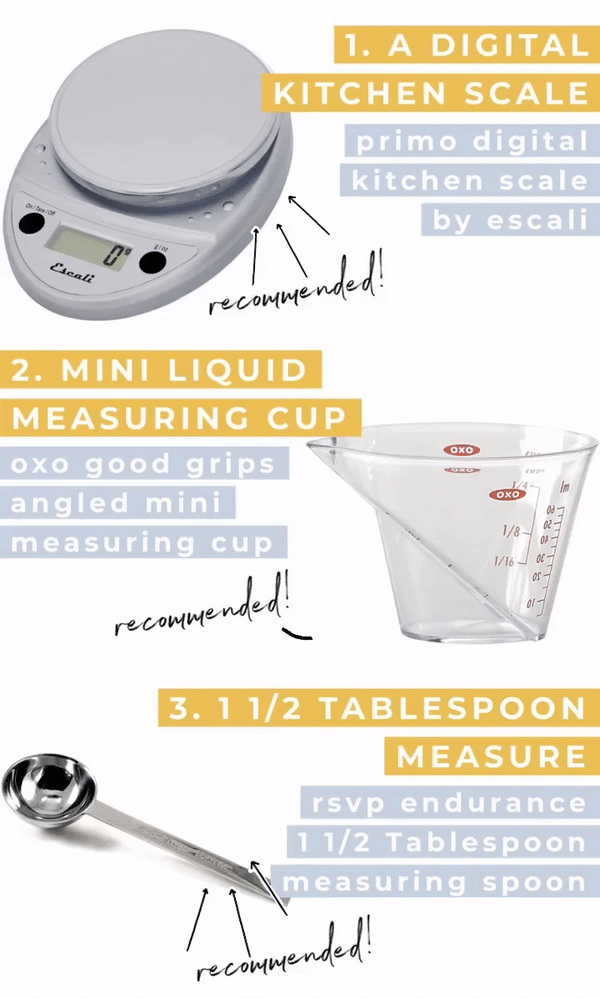
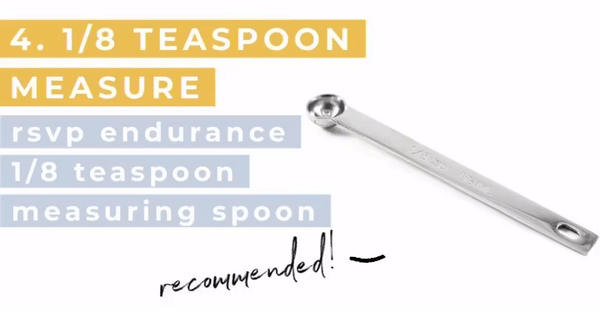
A Digital Kitchen Scale
Recommended Digital Kitchen Scale for Small Batch Baking: Primo Digital Kitchen Scale by Escali
Want to up your baking game without any effort whatsoever? Easy—invest in a baking scale (we’ll talk about that more in a second). A good scale usually clocks in at under $30, and offers readings in a variety of measurements like grams, milliliters, and ounces. For small batch baking, a digital scale can be a lifesaver. Many recipes don’t halve or quarter easily in terms of volume (think about it: what’s half of ⅓ cup?). But with a scale, you can easily half the ingredient’s weights without dealing with pesky fractions.
And if you want a good scale, I really recommend the Primo Digital Kitchen Scale by Escali. It’s so reliable and sturdy that it’s recommended by several major food players like The Kitchn and New York Times’ Wirecutter, too.
Why A Digital Scale is One Of The Best Small Batch Baking Tools (and General Baking Tool, Too) You Can Buy
- A digital scale provides the most accurate way to measure out ingredients.
Here’s the truth about measuring cups: the weight of 1 cup of any ingredient (flour, sugar, milk, whatever else) can vary considerably depending on how the cup was filled. Somebody who scoops flour into a measuring cup and packs it down will likely have a cup of flour that weighs more than somebody who simply scoops the flour into the cup and levels it off once it’s filled. his is why bakers love measuring by weight with a digital scale instead of by volume with measuring cups. It’s much more reliable, since it completely eliminates the inconsistencies that come from using measuring cups and volume measures. - A digital scale enables you to easily convert any recipe to a small batch baking recipe.
I already mentioned this, but it bears repeating: many recipes’ ingredient quantities, when listed in cups, don’t halve or quarter easily. You’ll need to do some complicated fraction arithmetic in your head, or convert cups to Tablespoon measures. But ingredient weight measures? That’s a different story—you can easily halve or quarter their weights without thinking twice about it. - A digital scale provides the fastest and cleanest way to measure out ingredients.
Most recipes instruct you to weigh out dry ingredients, then combine them in the same bowl to add to the batter or dough later at the same time. If a recipe instructs you to do this, weigh out the ingredients into the same bowl. Set a large bowl (or the size indicated in the recipe) on the scale, tare the scale so it reads “0,” then add your first ingredient to the bowl until the scale registers the desired weight. Tare the scale again and continue adding ingredients, resetting the scale to zero after you’ve added each one. Doing so eliminates the need to use a different measuring cup each time!
A Mini Liquid Measuring Cup
Why You Need A Mini Liquid Measuring Cup for Small Batch Baking
First things first: do you know about the difference between dry and liquid ingredient measuring cups? If you don’t, check out this Cook’s Illustrated article describing the differences in great detail. But the tl/dr is this: a liquid measuring cup looks like a mini pitcher, complete with a handle and a spout. Technically, liquid and dry measuring cups measure the same volume, but pouring a liquid ingredient into a dry measuring cup is a pain. You’ll need to fill it to the very brim, and then transfer it to wherever it needs to go without spilling. In contrast, liquid measuring cups have lots of extra room for the liquid to slosh around without spilling.
Recommended Mini Liquid Measuring Cup for Small Batch Baking: OXO Good Grips Mini Measuring Cup
This mini liquid measuring cup has a maximum capacity of 4 Tablespoons (which is equivalent to ¼ cup), with readings for 1, 2, and 3 Tablespoons. It’s perfect for small batch baking recipes, especially since most small batch baking recipes typically only require a few tablespoons of liquid ingredients.
A 1 ½-Tablespoon Measure
Why You Need A 1 ½-Tablespoon Measure for Small Batch Baking
I develop most of my small batch baking recipes by dividing the ingredient quantities of my favorite regular or large-batch recipes in half or in quarters. Often times, I have to divide 3 Tablespoon quantities in half. Doing so results in a 1 ½ Tablespoon measure for that ingredient.
Unfortunately, a 1 ½-Tablespoon measure isn’t typically available with most measuring spoon sets. Standard measuring spoon sets usually only come with the following four measures: ¼-teaspoon, ½-teaspoon, 1-teaspoon, and 1-Tablespoon. Although you can use a 1-teaspoon measure to measure out the equivalent of 1 ½ Tablespoon (which equals 4 ½ teaspoons), it’s clunky and awkward.
Recommended 1 ½-Tablespoon Measure for Small Batch Baking: RSVP International Endurance 1 ½-Tablespoon Measure
I love this 1 ½-Tablespoon measure so much that I even included it in the gift boxes for the launch of my cookbook! Pro-tip: if you ever lose a measuring spoon (or need doubles of a certain measure), RSVP International has your back. They sell different sizes of individual measuring spoons on Amazon and some kitchen specialty stores.
A ⅛-teaspoon Measure
Why You Need A ⅛-teaspoon Measure for Small Batch Baking
Similarly, a ⅛-teaspoon measure is one of the best small batch baking tools. Many regular-sized recipes usually call for ¼-teaspoon measures of ingredients. If halving a regular sized recipe that requires ¼ teaspoon of an ingredient, you’ll need a ⅛ teaspoon (since ⅛ is half of ¼).
Recommended ⅛-Tablespoon Measure for Small Batch Baking: RSVP International Endurance ⅛-Tablespoon Measure
Similar to my love for RSVP International’s 1 ½-Tablespoon measure, I love this ⅛-teaspoon measure so much that I even included it in the gift boxes for the launch of my cookbook!
Best Small Batch Baking Tools for Scraping and Scooping
I know it seems silly to get specialty scraping and scooping tools for small batch baking. But have you ever tried to use a huge rubber spatula to scrape out a tiny amount of something? It ends up being a mess, right?! So trust me when I say that smaller versions of your favorite rubber spatulas, offset spatulas, scoops, and more are absolutely worth it!
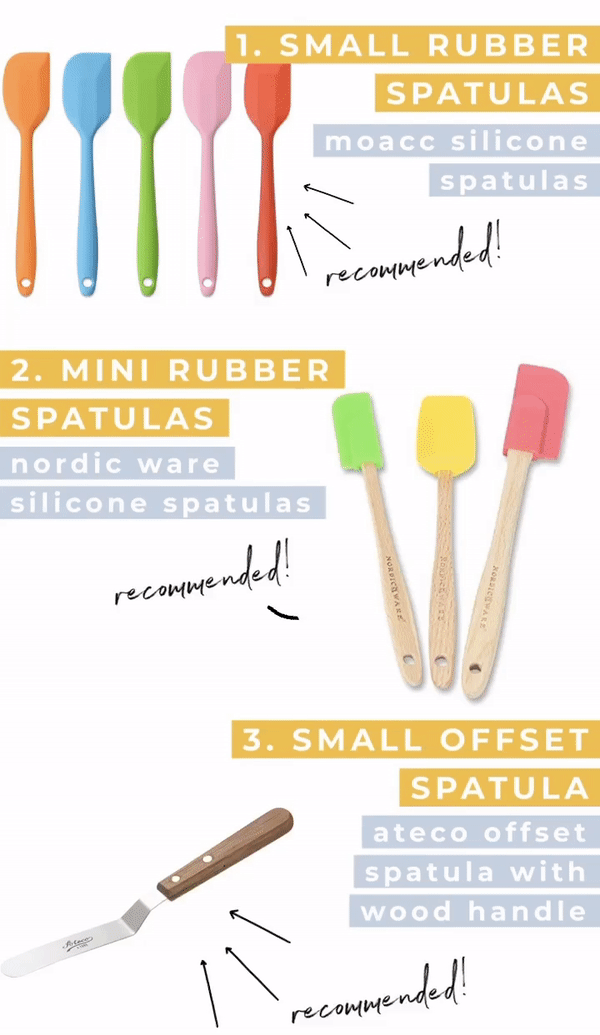
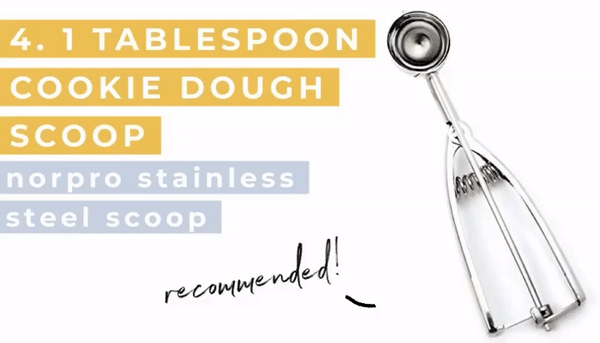
featured:
small spatulas || mini spatulas || offset spatula || cookie dough scoop
Small Spatulas
Recommended Small Spatula for Small Batch Baking: MOACC 8.5-inch Small Rubber Spatulas
I recommend two types of small spatulas for small batch baking. This MOACC one is the larger of the two, and perfect for small batch baking recipes with serving sizes for 3 to 4 people. I frequently use this spatula to scoop my dalgona coffee into a narrow-mouthed glass. Its small size makes narrow openings *really* easy to navigate!
Mini Spatulas
Recommended Mini Spatula for Small Batch Baking: Nordic Ware Mini Silicone Spatulas
This Nordic Ware mini spatula is even smaller than the MOACC spatula I recommended above. It’s perfect for scraping the nooks and crannies of tiny measuring spoons, small food processing bowls, and mini stand mixer paddle blades.
A Small Offset Spatula
Recommended Small Offset Spatula for Small Batch Baking: Ateco Offset Spatula with 4.5-Inch Stainless Steel Blade and Wood Handle
Most offset spatulas are designed to decorate big sheet cakes and multi-layer cakes. As a result, they have blades that are usually between 8- to 10-inches long. That’s far too big and cumbersome for a tiny sheet cake or 6-inch layer cake! I recommend scaling down to an offset spatula with a 4.5-inch blade. I like to use this Ateco offset spatula as it’s both functional AND photogenic. However, if you want a dishwasher friendly version, definitely opt for the Ateco offset spatula with a plastic handle instead.
A 1-Tablespoon Cookie Dough Scoop
Recommended 1-Tablespoon Cookie Dough Scoop for Small Batch Baking: Norpro Stainless Steel 35MM (1-Tablespoon) Scoop
A cookie dough scoop is the most underrated tool in the baker’s kitchen. Not only can it help you form perfect cookies every time, it’s also great for transferring cake batters and frostings. My favorite cookie dough scoop is this Norpro scoop. Its 1 Tablespoon size is incredibly versatile.
Small Batch Baking Recipes
Okay, now that you’ve learned everything you need to know about the best small batch baking tools, let’s get baking! Check out the small batch recipes below to put your new tools to use:
Small Batch Bar and Cookie Recipes
- Brownies (a specifically small batch recipe; makes 2 large, 3 medium, or 8 very petite portions)
- Flourless Chocolate Cookies (small batch option available in blog post; makes 4 large cookies)
- Magic Cookie Bars (a specifically small batch recipe; makes 2 large, 3 medium, or 8 very petite portions)
Small Batch Breakfast Pastry Recipes
- Banana Nut Muffins (a specifically small batch recipe; makes 6 muffins)
- Blueberry Muffins (a specifically small batch recipe; makes 4 muffins)
- Blueberry Scones (a specifically small batch recipe; makes 6 scones)
- Cinnamon Rolls (a specifically small batch recipe; makes 4 rolls)
- Pecan Sticky Buns (a specifically small batch recipe; makes 6 rolls)
Small Batch Cake Recipes
- Funfetti Sheet Cake (a specifically small batch recipe; makes 2 large, 3 medium, or 8 very petite portions)
- Mini American Flag Cake (a specifically small batch recipe; makes 2 large, 3 medium, or 8 very petite portions)
- Strawberry Sheet Cake (a specifically small batch recipe; makes 2 large, 3 medium, or 8 very petite portions)
- Yellow Birthday Layer Cake with Chocolate Ganache (a specifically small batch recipe; makes a 6-inch, double-layer cake)
- Yellow Sheet Cake with Chocolate Frosting (a specifically small batch recipe; makes 2 large, 3 medium, or 8 very petite portions)

